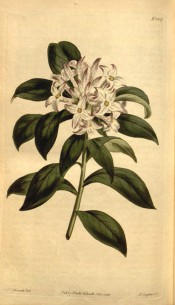Daphne odora Thunb.
Frost hardy, rounded, evergreen shrub with inversely lance-shaped leaves and terminal or axillary clusters of 10-15, fragrant, deep purple-pink and white flowers, to 1.5cm across, from winter to spring. To 1.5m. [RHSE, Hortus, Hilliers’].
Horticultural & Botanical History
‘Daphne odora generally passed in our Nurseries for some years as the indica, described by Osbeck as having opposite leaves and a stem only a span in height; which species has probably never been seen in this country. That, however, described as the indica, by Loureiro, seems to be very similar to odora, and may, perhaps, only be a variety of it with opposite leaves. This plant is hardy enough to survive our winters in the open air; but flowering in the coldest season, from December to March, it requires protection on that account. Indeed, unless the season prove favourable, it frequently fails of flowering altogether, otherwise it would be a most desirable acquisition; producing its highly fragrant flowers at a season when it has few rivals. […] Introduced in 1771, by Benjamin Torin, Esq.’ [BM t.1587/1813].
‘It has long been cultivated in England, and well deserves a place in every greenhouse. Its foliage is glossy and rich, and the flowers are produced very early in the year: their odour is peculiarly grateful, which adds much to its other attractions.’ [LBC no.1927/1835].
‘Of all the odoriferous plants with which I am acquainted, this is the most delightfully fragrant, surpassing, in the estimation of many, even the agreeable odour of the Rose itself, or of the Violet.’ [Gard. Chron. 1852].
History at Camden Park
Listed in all published catalogues [T.377/1843].
Notes
Daphne odora D.Don (1825) = Daphne cannabina Wall.
Published Mar 06, 2010 - 04:45 PM | Last updated Mar 06, 2010 - 04:51 PM
| Family | Thymelaeaceae |
|---|---|
| Category | |
| Region of origin | China, Japan |
| Synonyms |
|
| Common Name | Sweet-scented daphne |
| Name in the Camden Park Record |
Daphne odora |
| Confidence level | high |


